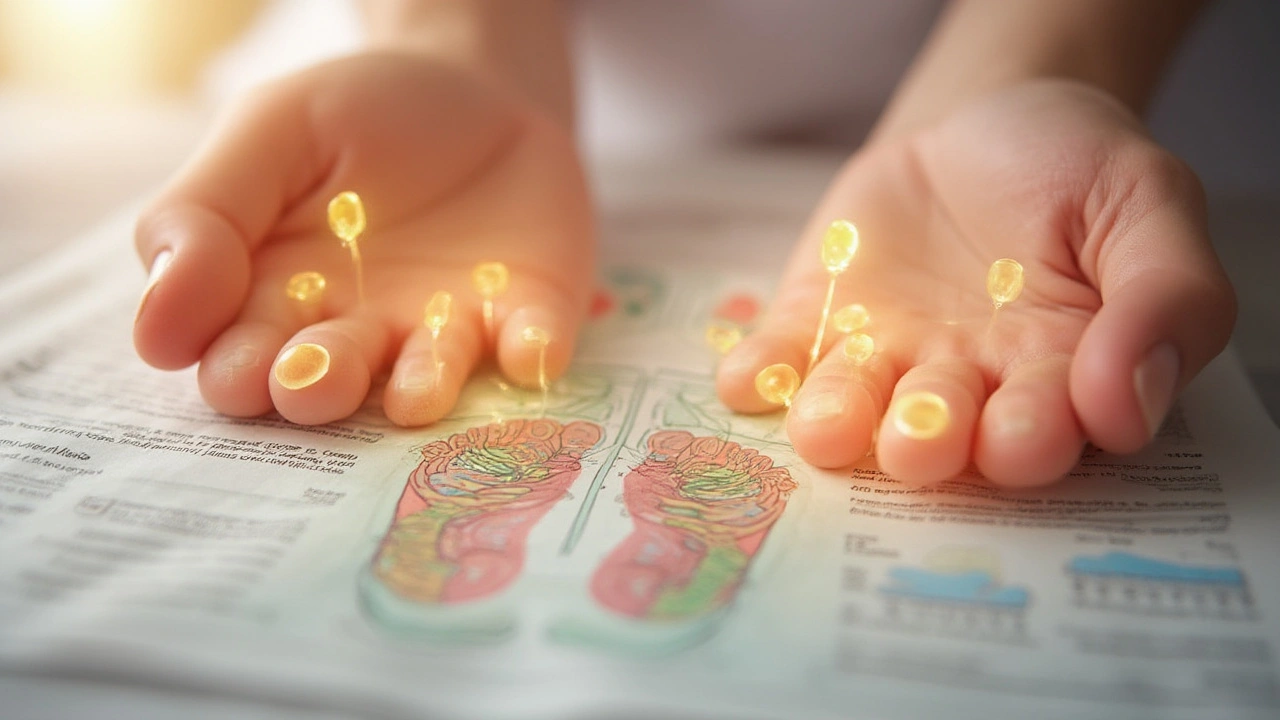Heartburn at midnight, that burning in your chest not letting you close your eyes—nothing ruins a night faster than acid indigestion. But here's something surprising: people have been fighting this same battle for thousands of years, and many keep coming back to an old-school, hands-on method—reflexology. It's not magic, and it's not a quick-fix pill. But more folks are using reflexology to help calm acid indigestion and give their digestion a break. Is this ancient method a gimmick, or does it hold real relief? Let's dig into the world of feet, hands, and the science of feeling better.
Reflexology Explained: What Is It and Why Try It for Indigestion?
Reflexology is weirdly simple in theory. The idea is that specific spots on your feet and hands (and sometimes ears) map to different Organs and parts of your body. Therapeutic pressure applied to the right areas is supposed to trigger a response—stimulating circulation, relaxing tension, and encouraging your body to rebalance itself.
Now, a lot of people associate reflexology with getting a nice foot rub. But there’s more to it than that, especially for digestive struggles like acid indigestion. For instance, the balls of your feet—just below your toes—are linked (in reflexology maps) to your upper abdomen. The arch is linked to the digestive tract and pancreas. Reflexologists believe that by pressing and rubbing these points, you might help the digestive system do its job, improve how acid moves, and reduce that burning, cramping feeling.
It’s not some fringe trend either. Reflexology dates back to ancient Egypt, with wall paintings in the tomb of Ankhmahor (around 2330 BC) that show people working on each other's feet and hands. In the 20th century, it got a boost from Dr. William Fitzgerald and later Eunice Ingham, who mapped out the first modern “zone therapy” diagrams, which today's practitioners still use as a reference. These charts help people target trouble spots linked to digestion.
But what about the science? In the last two decades, research on reflexology has grown. One notable study, published in Complementary Therapies in Clinical Practice in 2010, tracked people with chronic digestive problems, including acid reflux and indigestion. After just six weeks of weekly reflexology sessions, most participants reported noticeable improvement in bloating, stomach pain, and acid issues. Their sleep even got better.
Most Western doctors will say there’s not enough big, double-blind research to call reflexology a replacement for medicine, but many now call it a “useful complement.” In the real world, people aren't throwing away their antacids, but they use reflexology to cut the number of flare-ups and avoid reaching for pills as often.
The best part? Unlike medications, reflexology doesn't cause dry mouth, drowsiness, or that weird chalky aftertaste. Unless you press too hard or ignore pain signals, it’s virtually risk-free. It's suitable for almost any age and can even be self-administered, which means you don't need to book a fancy spa treatment to get relief from acid indigestion.

How Reflexology Points Target Acid Indigestion and Support Digestion
So how do you actually use reflexology for acid indigestion? It comes down to knowing the “maps” of your feet and hands—where to press if your goal is to help your digestion work better. According to reflexology charts, several points make a difference when you're facing heartburn or acid indigestion:
- Solar Plexus Point: On both feet, this is right where the foot narrows before arching—just below the ball of your foot, in the center. Gently pressing or rubbing here for 2-3 minutes can relax tension across the digestive system. This point is also famous for helping with stress, which often triggers indigestion.
- Stomach Point: It sits in the arch of your left foot, midway between heel and ball, along the center line. Circular rubbing here is linked to calming stomach upset and acid spikes.
- Pancreas and Liver Point: These run along the arch of both feet, just below the stomach area. Massaging this region could help balance digestion and improve how carbs—and acid—are handled.
- Small Intestine and Large Intestine Points: These line the outside edge of each foot, wrapping from the heel up to the pinky toe. Slow, sweeping massages along the edge can bring down bloating and ease cramps if the acid indigestion has made your whole belly feel tight.
What’s the method? Most reflexologists recommend pressing firmly but not painfully with your thumb, knuckle, or even a soft tool like a rounded pencil eraser. Hold the pressure for about five seconds per spot, repeat for a few minutes, and then switch feet and repeat. Some people use scented oils (like peppermint or ginger) while massaging, which adds another layer of soothing and supports healthy digestion.
The same logic applies to the hands. Reflexology points for digestive issues are found mostly on the palms—try massaging the padded area below the thumb (the “mount of Venus”), which corresponds to the digestive tract. You can do this while watching TV or sitting at your desk. No one needs to know you’re quietly fighting heartburn at work.
People often ask—does this method give instant relief? If the heartburn is mild, sometimes it does. Most often, the effect is gradual: the tension drops, your breath slows down, and the feeling of burning calms within 10 to 15 minutes. If reflux is triggered by anxiety, reflexology’s relaxation effect may hit even faster. People with more severe GERD report fewer major burn episodes after adding regular sessions. It’s not magic, but consistency seems to matter—sort of like brushing your teeth rather than waiting until there are cavities.
Reflexology stands out because it’s hands-on—literally. You’re not just masking symptoms but tuning into your body’s own reactions. Some folks combine sessions with other gentle therapies like yoga or deep breathing for even better results. And here’s a neat trick: finishing a session with a cool, moist towel or a drop of essential oil can boost the calming effect, making that chest and belly burn feel miles away.

Reflexology in Real Life: Tips, Tricks, and Making It Work for You
You might be picturing someone in a spa, eyes closed, lights dimmed, with tranquil music playing. Sure, you can do that—but you don’t have to. Reflexology is amazingly low-tech and works best when you make it part of your routine, not just a once-in-a-while fix.
If you want to try it at home for acid indigestion, keep these simple tips in mind:
- Consistency matters: Try to make a habit of massaging your feet or hands every evening, even if you’re not dealing with an active flare-up. You’ll likely see better results over time.
- Don’t overdo it: Press firmly, but never so hard that you feel pain. Soreness or bruising won’t help. Think “firm but gentle,” just enough to feel some warmth or tingling.
- Combine with lifestyle tweaks: Reflexology is most powerful when paired with smart habits—like eating smaller meals, sitting upright after eating, and skipping spicy or greasy late-night snacks.
- Stay hydrated: Drinking water before a reflexology session (but not too much right after eating) ensures your muscles, nerves, and digestion all work smoothly. Dehydration makes acid issues worse.
- Personalize your routine: Everyone’s feet and hands are shaped a little differently, and your “hot spot” might not match someone else’s exactly. Play around, notice which points make your symptoms feel better. Jot down what works—treat your relief sessions like your own at-home experiment.
- Don’t ditch your doctor: If you have severe acid reflux (“GERD”) or symptoms like blood in your stool or weight loss, reflexology isn’t a replacement for medical help. Use it alongside your doctor’s plan, not instead of it.
It’s actually easy to make reflexology part of your real-life schedule. Need a break from your computer? Take off your shoes, work those pressure points while you brainstorm. After dinner but before bed, sit on the couch and massage your feet for ten minutes. You can rope in a partner or friend for a session trade. Some people even use reflexology as part of a larger “relax and digest” ritual—think foot massage, calming tea, a few deep breaths, and reading under dim lights to wind down an acid-prone evening.
A few fun facts: Some marathon runners swear by reflexology for both recovery and digestion. A handful of small studies even found it can help decrease stress hormones after a tough day, which is relevant since stress can crank up stomach acid production. Professional reflexologists often report that clients with digestive complaints notice first the improved sleep, followed by lighter, calmer stomach feelings. If you love gadgets, there are foot rollers, spiky balls, and even electronic mats designed to hit these same pressure points—though nothing really beats your own hands or someone else’s.
Wrapping up, reflexology is not a miracle cure. But for a lot of people tired of popping antacids or being kept up all night, it offers a concrete, soothing way to take charge of acid indigestion. It works by literally putting you back in touch with your body, mixing ancient wisdom with a practical, modern twist. The next time acid bites after your favorite pizza or spicy curry? Skip the chalky tablets, and give reflexology a go. Feet up, hands ready—you might find relief right at your fingertips.

14 Comments
Kristy Sanchez
Oh wow another ‘ancient wisdom’ post that sounds like a TikTok ad for crystals and lavender oil. My grandpa used to rub his feet with Vicks and call it ‘Chinese medicine’ - turns out he just liked the smell. Reflexology? Sure, if you enjoy paying $120 for someone to press on your toes while you zone out to whale sounds. I’ll stick with Tums and not lying down after tacos.
Dominic Fuchs
Look i get it you want to feel like you’re doing something ancient and mystical to fix your stomach but honestly the only thing that’s ancient here is the pseudoscience. People have been burning witches for bad digestion too. Still waiting for the double-blind study where reflexology beats a placebo with the same pressure technique on a random spot like the left earlobe. Until then i’m gonna keep my antacids and my skepticism.
Kenneth Lewis
ok but like i tried this last night after burritos and honestly it kinda worked for 10 mins? idk maybe placebo or maybe my thumbs are magic. i pressed the ball of my foot and suddenly i wasn’t screaming into my pillow anymore. still took 2 tums but at least i didn’t cry. weird.
Leigh Guerra-Paz
This is so beautiful!!! I’ve been doing reflexology for my acid reflux for 6 months now and it’s changed my life!! I do it every night with my partner and we use lavender oil and play soft jazz and it’s like a little ritual of self-love!! My stomach hasn’t burned like this since college!! I even started journaling after each session and it’s helped me connect with my body in ways i never thought possible!! You’re not just massaging your feet-you’re healing your soul!!
King Splinter
Let me get this straight-you’re telling me that if I press on my foot, my pancreas magically gets a text message saying ‘hey chill out with the acid’? And this is somehow more legitimate than a pill that’s been tested on 20,000 people? I’m sorry but if your body’s chemistry can be fixed by thumb pressure then why don’t we just start massaging our livers to cure cirrhosis? Next you’ll tell me that humming at the right frequency will dissolve kidney stones. This isn’t holistic healing-it’s spiritual wishful thinking wrapped in a foot chart from 1913.
Tionne Myles-Smith
Y’all are overthinking this so hard. I’m not saying it cures everything but if you’ve got a little heartburn and you’re already up at 2am scrolling through your phone-why not just take 5 minutes to rub your feet? No harm. No cost. Feels nice. Maybe it helps. Maybe it doesn’t. But at least you’re not reaching for a chemical that makes your mouth feel like a chalk factory. I say give it a shot. You’ve got nothing to lose but a few minutes and a little tension.
Joanne Beriña
Of course Americans love this nonsense. We don’t trust real medicine so we turn to foot rubs and crystals. In India we have Ayurveda-real ancient science, not this ‘press here and hope’ garbage. You think Egyptians had foot charts? They had actual physicians. You think they massaged feet for acid? No-they used herbs, fasting, and discipline. This is what happens when you outsource your health to Instagram influencers.
ABHISHEK NAHARIA
Reflexology as a medical intervention is a classic example of confirmation bias dressed in cultural nostalgia. The Egyptian tomb depictions cited are not diagnostic maps-they are artistic representations of social rituals. The 2010 study had a sample size of 47 with no control group. No reputable medical journal considers this evidence. The placebo effect is powerful, yes-but it does not justify replacing evidence-based care with foot diagrams sold on Etsy. If you want to reduce acid reflux, reduce sugar, reduce eating before bed, and elevate your head. Not your toes.
Michael Friend
So let me get this straight-you’re recommending I spend 20 minutes a day pressing on my feet instead of taking a $2 pill that works in 3 minutes? And you call this ‘modern twist’? I’m not anti-alternative medicine-I’m pro-not-being-a-sucker. Next you’ll say acupuncture fixes my broken leg. I’ve seen the charts. The foot is not a map of the digestive tract. It’s a foot. With toes. That’s it.
Asbury (Ash) Taylor
It’s worth noting that the relaxation component of reflexology is likely the real mechanism here. Stress is a known trigger for acid reflux. If pressing on your feet helps you slow down, breathe, and disengage from the anxiety loop-then yes, it’s a legitimate tool. Not because of meridians or energy zones-but because it forces you to pause. That pause? That’s the medicine. You don’t need a chart. Just a quiet moment and your own hands.
Jordyn Holland
Oh great. Another ‘natural remedy’ post from someone who clearly thinks ‘organic’ means ‘not scientifically proven but feels good’. Did you also try chanting to your gallbladder? Or wearing a copper bracelet to ‘balance your pH’? I’m genuinely curious how many people are still convinced that touching their own feet is a viable alternative to proton pump inhibitors. The fact that this gets published as ‘science adjacent’ is why people think vaccines cause autism.
Jim Daly
bro i tried it and it worked for like 2 mins then i forgot i was doing it and ate a whole bag of chips. so now i have heartburn AND regret. reflexology is just a fancy way to say ‘rub your feet and hope’. also i pressed the wrong spot and now my pinky toe hurts. worth it? no.
Jasper Arboladura
The entire premise rests on a fundamental misinterpretation of somatotopic mapping. The foot’s neural representation in the somatosensory cortex does not correspond to visceral organ function in any clinically validated way. The zone theory is a 19th-century anatomical fantasy. The 2010 study you cite was underpowered, unblinded, and failed to control for concurrent lifestyle changes. To endorse this as a ‘complement’ is to mislead patients. Evidence-based medicine does not operate on anecdote, tradition, or aesthetic appeal.
Jerrod Davis
While the anecdotal reports of subjective improvement are not without merit, it is imperative that we maintain a rigorous distinction between palliative comfort measures and therapeutic intervention. Reflexology, as presently constituted, lacks sufficient empirical validation to be classified as a clinical modality. That said, if a patient derives psychological benefit from a non-invasive, low-risk practice-provided it does not supplant evidence-based treatment-it may be regarded as a benign adjunct. One must, however, exercise extreme caution against the commodification of pseudoscience under the guise of wellness.